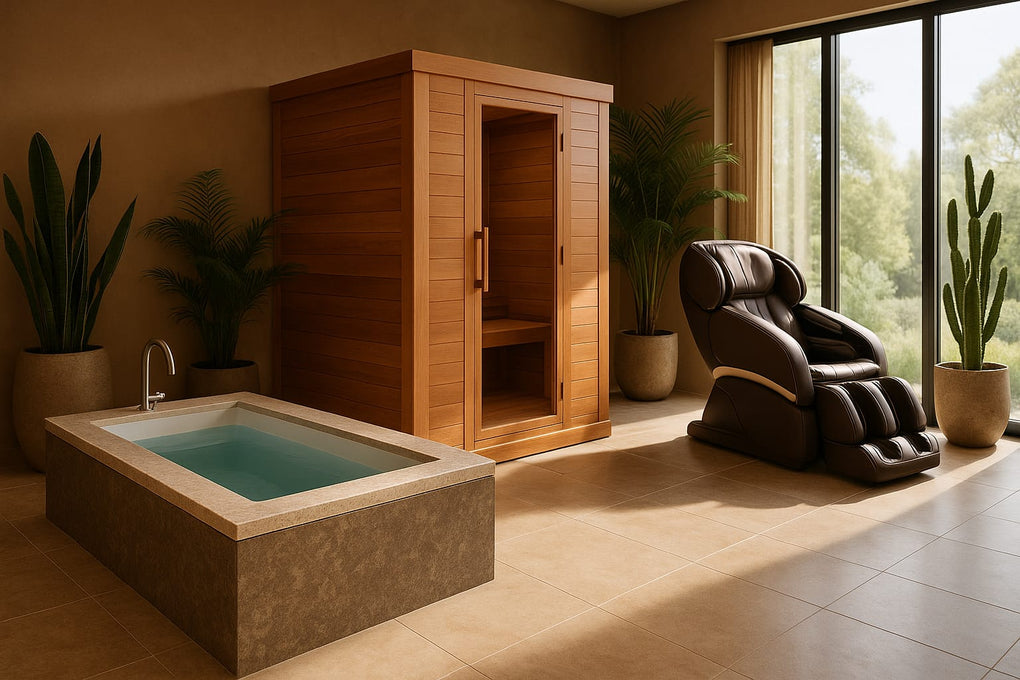Why Build a Home Spa?
A thoughtfully designed home spa brings clinical-grade recovery and daily stress relief into your routine. The right mix of heat, cold, light, and massage can improve sleep quality, support training adaptations, and reduce tension—without leaving the house.
Core Categories to Consider
Infrared & Traditional Saunas
Saunas deliver deep warmth that supports relaxation and circulation. Choose between infrared saunas for efficient heat with lower ambient temperature or traditional saunas for a classic, high-heat experience.
- Best for: Relaxation, recovery, routine wellness
- Room needs: Dedicated corner or small room; ventilation clearance per model
- Power: Many 120V options; larger units require 240V
Hot Tubs & Soaking Spas
Hot tubs turn any evening into a decompression ritual, with hydrotherapy jets and ergonomic seating designed for muscle relief and social time.
- Best for: Family wind-down, muscle recovery
- Placement: Level pad or deck; proximity to power and hose
Cold Plunge Tubs
Cold plunge tubs support contrast therapy, helping reduce perceived soreness and delivering a crisp, invigorating reset post-workout or first thing in the morning.
- Best for: Athletic recovery, mental focus
- Water care: Follow filtration and sanitation schedule per unit
Massage Chairs
Massage chairs provide targeted kneading, air compression, and heat for neck, back, and legs—great when you don’t have time for an appointment.
- Best for: Daily tension relief, posture support
- Fit check: Measure doorways and recline clearance
Red-Light Therapy
Red-light therapy panels are a compact way to round out your wellness stack, with short, consistent sessions that integrate easily before or after training.
- Best for: Consistent, time-efficient wellness routines
- Setup: Wall mount or stand; eye protection recommended
Quick Comparison
| Category | Primary Benefits | Typical Session | Footprint |
|---|---|---|---|
| Infrared Sauna | Relaxation, circulation, routine wellness | 20–30 minutes | Closet- to room-size |
| Traditional Sauna | Classic high heat, social ritual | 10–20 minutes | Room-size with ventilation |
| Hot Tub | Hydrotherapy, family time | 15–30 minutes | Patio/deck or pad |
| Cold Plunge | Recovery, alertness | 2–5 minutes | Small to medium |
| Massage Chair | Targeted muscle relief | 10–20 minutes | Recline clearance needed |
| Red-Light Panel | Time-efficient routine add-on | 5–15 minutes | Minimal |
Planning Your Space
- Measure first: Confirm footprint, doorways, and delivery path.
- Electrical: Many small units are 120V; saunas/hot tubs often require 240V—consult a licensed electrician.
- Floor & moisture: Use a level, well-drained surface; follow manufacturer clearances.
- Water: For hot tubs/cold plunges, review fill/drain access and water care.
Build a Balanced Routine
Stack modalities for synergy: sauna or red light to warm up, training, then a brief cold plunge to finish; add a massage chair session at night for sleep prep.
Recommended Next Steps
- Pick your primary modality (heat, cold, massage, or light).
- Confirm space, power, and delivery path.
- Compare 2–3 models and read current lead-time notes on the product page.
- Add accessories (floor mats, thermometers, water care kits) to simplify maintenance.
FAQs
What’s the best first purchase for a small space?
Start with a compact infrared sauna or a wall-mounted red-light panel. Both fit easily and deliver daily value.
Can I combine heat and cold at home?
Yes—pair an infrared sauna or traditional sauna with a cold plunge tub for contrast therapy. Start with short sessions and listen to your body.
Do I need 240V for a sauna or hot tub?
Some smaller saunas run on 120V; many larger saunas and most hot tubs require 240V. Check the product specifications and consult a licensed electrician.
How do deliveries work?
Most large items ship via scheduled freight with curbside delivery. Review the delivery path (gates, stairs, tight turns) in advance and consider white-glove options if needed.







Leave a comment